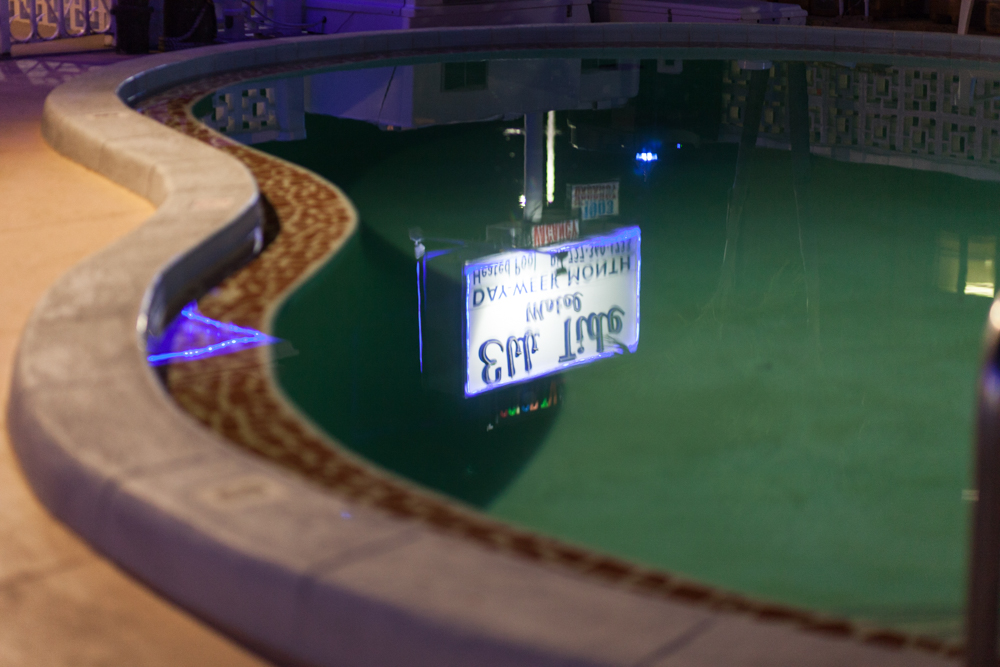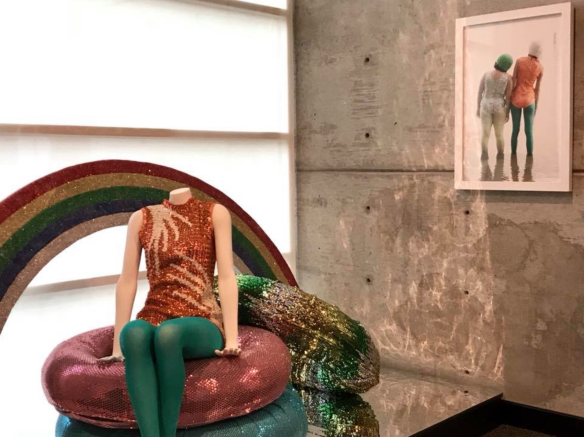Disturbed by Delight
by Caitlin Albritton
“Woman dressed as a turkey arrested for shoplifting,” “Someone donated a loaded grenade launcher to Goodwill,” “Man claims wife was kidnapped by holograms”—please, don’t let this be a headline from Florida, a local might plead. I can’t begin to imagine how non-Floridians make sense of the Sunshine State: how can so many bizarre stories come out of a place so seemingly utopic? While this handle of land has been distilled into a variety of assumptions, Florida native Selina Román uses photography to usurp these presumptions by reveling in its beauty and strangeness in her solo exhibition A Liminal State at the Leepa-Rattner Museum of Art. While her exhibition encompasses five bodies of work, most of her solo show revolves around the Please Disturb series and the related Please Disturb: LRMA Edition.
Travel has always been a way to understand a place. In the heyday of road trips in the first few decades of the 20thcentury, the popularity of the automobile lifted the boundaries of economic status and permitted an escape from the everyday. What a better way to welcome Florida-bound tourists than with family-run motels that offer dreams of relaxing seas and palm tree paradise. Yet with contemporary travel, it’s no longer about the journey but getting to the destination as quickly as possible. Travel has lost its spark, while forgotten motels now serve as an embodied representation of Florida—with its own fantasies and unfulfilled dreams. Swaddled in a potentially unwashed comforter, this state encapsulates everything weird, sexy, funny, and mysterious about this peninsula.
So, let’s linger in these transient spaces a bit longer.
“What would happen if I brought a readymade to a motel?” I’d like to think this is how Román decided to turn dated Florida motel rooms into her temporary studio space for her Please Disturb series, inviting her friends and other guests in for intimate photoshoots full of vintage props and 80s beauty products: tasseled majorette uniforms, frilly swimming caps adorned with silk rosettes, and facial treatment masks, all haloed by a barrage of sequins that glitz like fish scales in the sultry lighting. The commissioned LRMA Edition is just as bedazzled, but instead of photographing people she knew, this was the first-time strangers—museum docents and members— had been invited to her room at the Tarpon Shores Inn.
Alter egos arise under the cover of costume.
There’s a bit of improvisation and performance on Román’s part in setting up these rooms, from the careful arrangement of costumes in open-plan closets to the posing of her models; there may be some ideas in mind, but for-the-most-part, all parties involved allow fluidity in the process. Instead of chastising our inherent interest in gazing at others, Roman’s admission of our society’s voyeuristic tendencies whispers to us: don’t mind if you do.
While motels are often the sites of her photographs, other innately Floridaesque locations insinuate the condition of transformation: beaches, fresh-water springs, or abandoned public pools as evidenced in the other series on display.

What makes her photographs alluring is the fact that they resist direct eye contact; if our eyes are windows to the soul, most of Román’s are coyly shuttered (even the motel’s street-front signage is bashful, its watery reflection mirrored via pool in Ebb Tide). In 15thcentury Italian paintings, many painters would rely on the viewer’s disposition to read into relationships within the work. In a poetic treatise on painting by the artist-philosopher Leon Battista Alberti, he says, “Movements of the soul are recognized in movements of the body.” Searching for emotional keys in body language and relationships between the figures and their flirtatious props (as well as cheeky titles), Román mixes the familiar with the foreign to create moments of captivating uncanny.

In looking for what questions Román’s work asks of us, I found one in the title of one of her pieces: Is the Fantasy Better than the Reality? an inkjet transparency lit from behind to create a soft blue glow in the background. A woman’s curvaceous silhouette lounges in waiting: a fishnet shirt is stretched over the morsel of breast we can fathom from our view behind her. Her short red wig glows from another light source, and we can make out the porous plastic material that makes up the wig’s artificial lining, not even trying to create a perfect camouflage of her natural hair that peeks out beneath it. After a while, you’ll notice it: the sliver of hairy chest she is leaning upon.

It feels too easy to say that, “Fantasy is better!” since each figure is wrapped up in their own alternate universe that escapes the dregs of real life. Either way, Román seems unwilling to show her cards on which she believes is “better,” equally considering both sides. Hints to this lie in how the perfect image of fantasy is disrupted in her iconic photos, from the awkwardness of a bathing-suit-clad body stuffed through a pool chair like in Low-Grade Euphoria, to the absurdity of wearing silicone lips that promise to make your jawline slenderer and more appealing, seen in Maybe She’s Born With It.

Glitter is good at hiding disheveled, grubby spaces, is it not?
So, perhaps the answer Román is getting at is that reality impedes imagination. Another rift in the fantasy comes from the prop vignettes throughout the exhibition. The solidity of these props grounds the viewer—Oh, this is what it really is! —slightly shattering the ephemerality of the images by gently steeping them in reality.
In a contemporary art scene where “meaning” feels prized over aesthetics, it seems that Román is also asking how uncanny or unconsidered beauty can be used purposefully to balance the weighted scales of daily burdens. How does the old Hollywood glamour in her LRMA Edition of Please Disturb empathetically portray the sensuality of an aging woman? How can we simmer in the magnificence of nostalgia without agonizing over the past? How can we celebrate and create an identity for transience by shedding a new light on all of the stuff we didn’t know we should be considering as instigators of awe and wonder?
For those who have yet to put their finger on the pulse of what makes this state tick, Roman’s provocative works are like being baptized in the heavily chlorinated waters of Floridian mythology: there’s an element of folklore that reaches towards the fantastic, yet is firmly rooted in reality. Deeply mysterious, it’s the kind of artwork that quivers the stillness of the imagination in an age of excessive data that tries to stifle it.
I am content in being a voyeur in these calm, intimate moments, where I am disturbed by delight.
Caitlin Albritton is an artist and freelance writer based in Tampa with a BFA from Savannah College of Art and Design and an MFA from Maryland Institute College of Art. When she’s not looking at art throughout town, she can be found making it. You can keep up with her visual art on Instagram @caitlinalbritton or on her website.
In partnership with Smithsonian Museum Day where participating museums (such as the Leepa-Rattner) will have free admission, the Leepa-Rattner Museum of Art will be hosting the event Concealed: A Photoshoot with Selina Románfrom 11 a.m.-1 p.m. on September 22, 2018, for the last weekend of A Liminal State, which will be up through September 23rd. Visitors are encouraged to bring their own props and will have the opportunity to have a Polaroid of themselves to bring back home.
